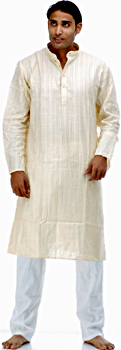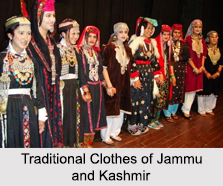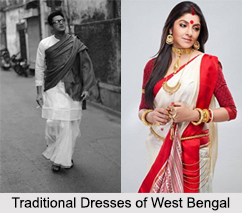 Known as the "Land of Buddha," Bihar is a state deeply rooted in art, religion, and cultural heritage. With its rich history and diverse social groups, Bihar`s costumes reflect the amalgamation of various influences. From traditional textiles to exquisite jewelry, the people of Bihar proudly embrace their cultural attire.
Known as the "Land of Buddha," Bihar is a state deeply rooted in art, religion, and cultural heritage. With its rich history and diverse social groups, Bihar`s costumes reflect the amalgamation of various influences. From traditional textiles to exquisite jewelry, the people of Bihar proudly embrace their cultural attire.
Costume of Men in Bihar
The traditional dress of Bihar for men is the Dhoti Mirjai, also known as Kurta and Dhoti and Lungi is often considered as casual wear. Dhoti Mirjai holds immense significance and is widely worn by elderly men, middle-aged men, and even boys. Made primarily of cotton, these outfits are suitable for everyday wear. While the basic styles offer comfort and ease of wearing, the festive versions boast intricate designs, ornate borders, and elaborate embroideries. Lungi is a loose-fit bottom wear made of pure cotton fabric and is mostly worn at home for comfort.
The Dhoti or Lungi is a type of cloth wrapped around the legs and knotted at the waist but they differ in the technique of draping. This attire adds a touch of tradition to the ensemble. It complements various body types and lends an authentic Indian look. Although traditionally, the dhoti requires meticulous tying, readymade options are now available, featuring a wide range of designs, colors, and patterns.
 Another popular choice for men in Bihar is the Kurta and Pajama combination. The kurta, a loose shirt that falls below the knee, is crafted using diverse fabrics such as cotton and silk. While the basic styles feature minimal embroidery or motifs, the festive versions incorporate intricate chikan work. The kurta is paired with cotton pajamas, creating a traditional Indian ensemble that exudes elegance and simplicity. This attire is commonly worn for daily activities, as well as on wedding, festive, and religious occasions.
Another popular choice for men in Bihar is the Kurta and Pajama combination. The kurta, a loose shirt that falls below the knee, is crafted using diverse fabrics such as cotton and silk. While the basic styles feature minimal embroidery or motifs, the festive versions incorporate intricate chikan work. The kurta is paired with cotton pajamas, creating a traditional Indian ensemble that exudes elegance and simplicity. This attire is commonly worn for daily activities, as well as on wedding, festive, and religious occasions.
For special events like weddings and festivals, men in Bihar opt for the regal Sherwani. Consisting of an embroidered jacket that reaches the knees or calves, the sherwani is accompanied by pajamas, dhoti pants, or churidars, which are tightly fitted pajamas. The jacket is available in a plethora of styles, designs, patterns, and color combinations. It often features heavy and intricate work, creating a captivating and majestic appearance.
Notably, the men of Bihar display a fondness for ornaments. Bala or bali (bangles) are adorned by individuals from Shahabad, Kanausi, Patna, and Gaya. Additionally, Gowalas (milkmen) often sport Kundals (earrings). The popularity of malas or bead necklaces is also on the rise among men in Bihar.
Costume of Women in Bihar
Saree stands as the epitome of traditional dress in Bihar for women. Available in a wide range of colors, fabrics, and designs, the saree holds a special place in the hearts of Bihari women. The "Seedha Anchal" style, wherein the pallu of the saree is worn on the front side, is particularly popular in Bihar. It drapes over the left shoulder, covering the upper portion of the body. While some women choose to cover their heads with the pallu, others opt for a regular style. To enhance their saree look, women embellish themselves with various traditional jewelry pieces, including necklaces, earrings, maang tikkas, waist belts, and toe rings. Lehengas, also known as ghagra choli, are worn by women on festive occasions, religious events, and weddings. These elaborate outfits add a touch of glamour and elegance to any celebration.
In Bihar, the choice of costumes for women is carefully made to uphold tradition. Married women traditionally apply Sindoor, a vermillion powder, to their hair parting. They also adorn their hair with Tikli, a small ornament placed at the hair partition. Bihari women commonly wear bindis on their foreheads, and many accentuate their eyes with Kajal or Surma, enhancing their beauty. Aromatic oils are used to refresh the mind and body, providing a soothing experience. Tattoo paintings, especially on the hands using Mehendi designs derived from herbal products like amla or shikakai, are prevalent among Bihari women.
The passion for jewelry among women in Bihar is evident, with elaborate designs and extravagant accessories. Chandrahar, Tilri, Panchlari, Satlari, and Sikri are just a few examples of the ornaments accompanying women in Bihar. Necklaces, bangles, rings, and anklets are among the myriad accessories worn on the hands, wrists, fingers, and ankles. Beauty consciousness is ingrained in the feminine nature, even extending to the tribal women of Bihar. Both men and women in tribal communities wear a thin strip of cloth around their waists, keeping separate pieces for everyday wear and going out. Dhotis are commonly worn by men, while women drape themselves in sarees.
Tattoos are prevalent among tribal populations, reflecting their belief in magic. Tribal elegance in Bihar embraces simplicity as a mantra, which enhances the aura of elegance in their costumes. The costumes of Bihar exhibit the richness, refinement, and immeasurable worth of a heritage that remains glorious even in the face of changing times.
The costumes of Bihar represent the deep-rooted cultural heritage of the region. Whether in everyday life or during festivities, the people of Bihar take pride in preserving their customs through their choice of attire. It reflects Bihar"s vibrant cultural identity, showcasing the richness of art, religion, and tradition that defines this remarkable land.





















